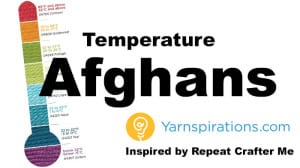
Temperature Afghan
Years ago, Bernat Yarns prior to rebranding themselves as Yarnspirations had a blog where they used a Yarn Temperature Gauge for making unique afghans, generally referred to as a Temperature Afghan.
I was reminded of this when Sarah, founder of Repeat Crafter Me, posted this as an idea for crocheters. I've been looking for this gauge and was unable to find it. Thanks, Sarah for the reminder!
Getting Data from the Past
If you don't know the temperatures of the past, you can find them pretty easily. I have written a blog on where to get the information plus there are 4 examples from Crochet Crowd Community Members to gawk at too! Where to Find Temperature Information.
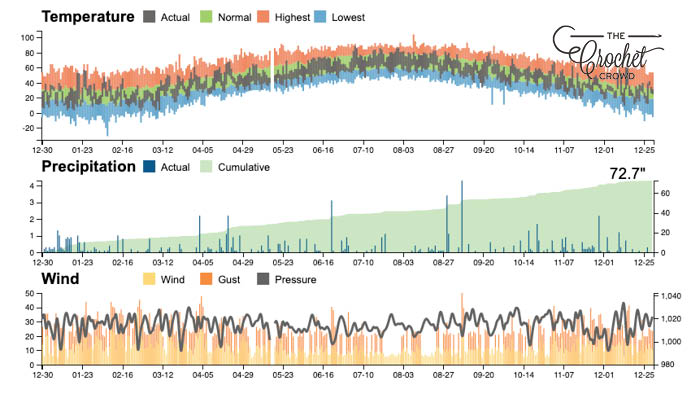
How A Temperature Afghan Works
If you have never heard of a Temperature Afghan, it's pretty straight forward. You commit to crocheting 1 - 3 rows/rounds of your work using the temperature gauge as your colour choice each day. So you can either check your temperature outside of your home or refer to the weather network each day and crochet accordingly. If you think you are not going to crochet for a day, just take the temperature and write it down so when you pick up your project, you have that information handy.
The temperature gauge is showing 6 colours of Caron One Pound yarn.
Once you know the temperature, look at your gauge and crochet the colour that falls within the temperature readings.
The trick is not to cheat the system by falsifying a temperature because you think the colour shouldn't go where it does. The whole point is capturing the temperature as it happens making the afghan a true representation of the season you are crocheting in.
PSST... if you cannot start on the first of the month, you can start anytime, when you are done, no one is really going to know if you started on a the 1st of the month or had to delay it.
Customizing Your Temperature Gauge
In my region of the world, the chances of it hitting anything above 54 - 66 degrees is unlikely at this time of year. So what I would do is to change the temperatures to be closer to what is normal for your region.
So I would just stroke out the temperatures and redo the gauge that is closer to temperatures that are possible. For example, I would actually put my lowest temperature to be up to -20 degrees and work up increments all the way up to a maximum to 13 degrees as my highest point. Be creative, just because there are 8 increments that don't mean you have to have only 8, you can have more colours and closer temperatures.
I would also look at the yarn colours and you can change out the yarn colours too depending on what is in your collection or making something that more reflects your own personal tastes.
To help you further, I have created a downloadable PDF of the Temperature Gauge so you can make your own notes or alterations.
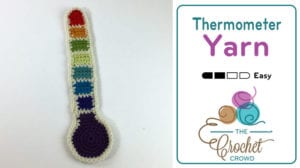
Thermometer Applique
I have written a pattern called the Yarn Thermometer. This pattern will show you how to make an applique that can be applied to your Temperature Afghan.
The colours you have selected for your project are to be used in the thermometer. Once you are done this applique and your project are done. Simply sew this onto the corner of the afghan.
To help you remember what the colours mean, the gauge shows the colours in order of the temperature. So when you look at the project, you can look at the thermometer and remember the temperature increments.
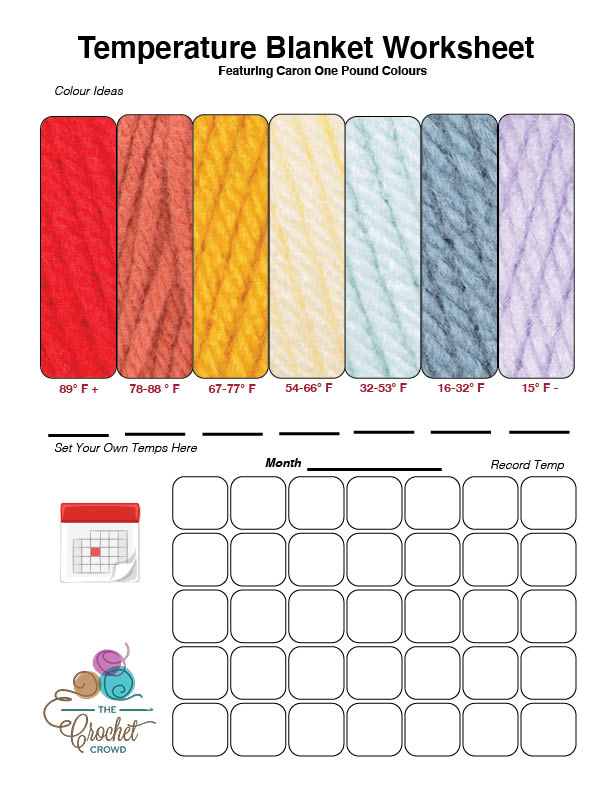
How Many Chains to Start Worksheet
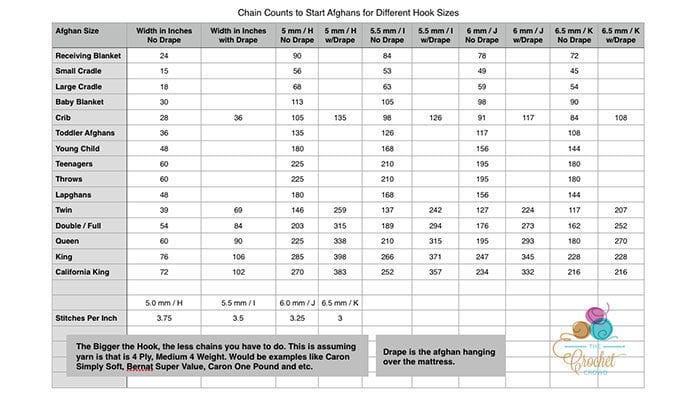
Tips on Selecting the Right Stitch
The Afghan may be up to 365 rows. Based on single crochet using Caron One Pound with a 5 mm or H Hook, 3 days equals 1 inch of height. This means the afghan will be 121" long. If you have seen most temperature afghans, it's way too long and isn't practical.
So I attempted doing slip stitching and I know what you are thinking, 'Slip stitching' an entire afghan is crazy. But wait. You have to do 365 rows. Slip stitching with 5 mm or H Hook using Caron One Pound, you can get 8 days in just 1". This will give you an afghan that is really tight and approximately 46" long instead.
If you want texture, when you are slip stitching, use the front loop only. This will give a unique look and make the afghan have elastic look and feel to it.
If you do a lapghan size of 180 chains to start. You can create an almost square lapghan. Then you can add on a border to make it slightly bigger.
Tutorial
What Types of Projects Can You Do?
It's usually done in granny format but you can follow your own rules or designs. Here is a list of 5 patterns that are great for this. Again, be creative.
Soo Law says
These are so lovely! But here in England we don't get the huge variations of temp as you do in Canada...it might not look so good...x
Sarah Boonzaier says
You could adjust it so that every 2- 3 degree changes result in a different color!
Wanetta says
Tried to order the yarn but two colors are not on the list. Lagoon and Foliage. Disappointing.
Mikey, The Crochet Crowd says
The temperature thermometer is nearly 4 years old. Sounds like some colours have been discontinued. Sorry for the inconvenience. - Michael
Carolyn Bartholme says
Has anyone done a temperature afghan and added precipitation in? I heard using grey or rain, and white for snow. Any suggestions??????
Jeanne - The Crochet Crowd says
I have seen some do that! They had some drop stitches for rain and white bobbles for snow. I think it was posted in our group.
https://www.facebook.com/groups/905296302884699/
Ashleigh C H Upadhyaya says
I am going to do this. Bass pro shop sells a tinsel fishing wire that I will use (as in a milti strand row) for rain, and I have seen people do a popcorn stitch for snow. I have seen snow done in only white, but I will be doing my popcorn stitch in the color/temperature of the day, since it can snow at at least three of my color choices! =)
Judie Harper says
What about using a lighter weight yarn (2 or 3) and doubling temperature color with weather color?